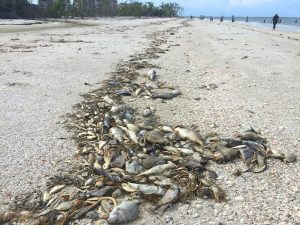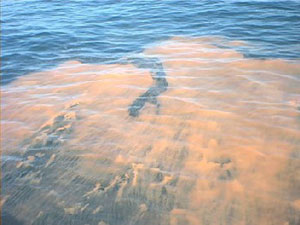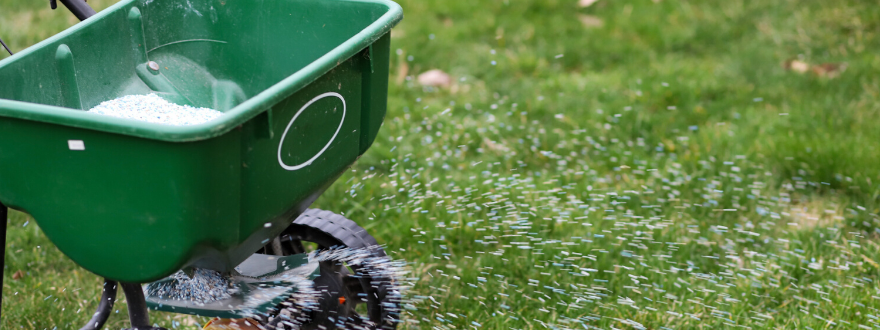
Photo by Jillian Cain
Tampa Bay is healthier than it’s been since the 1970s because local governments and businesses have invested over $2.5 billion to clean up the pollution caused by excess nitrogen — stopping about 530 tons of nitrogen from entering Tampa Bay since the 1990s.
But a small proportion of the region’s population still using residential fertilizer at recommended application rates can import thousands of tons of nitrogen every year, says Ed Sherwood, executive director of the Tampa Bay Estuary Program.
Here’s how he figures the impact of residential fertilizers in Tampa Bay:
- As of 2017, 40% of the land in the bay’s watershed was classified as urban or suburban development — representing a 43% increase (160,000+ acres) since 1990.
- If just 10% of the current population fertilizes only an eighth-acre of lawn at recommended rates on those lands (about 350,000 homes with 5,000 square feet of lawn at two pounds of nitrogen per 1,000 square feet), then almost 1,750 tons of nitrogen would be sprinkled across the watershed.
- Best-case scenario: The lawn assimilates 95% of that fertilizer, no fertilizer was left on impervious surfaces, like driveways and sidewalks, and no nutrient-saturated soils or grass clippings stimulated by fertilization were allowed to enter the stormwater systems.
- “Even then, you’re still talking about 87.5 tons of nitrogen released into groundwater or stormwater systems every year,” Sherwood said.
And once it’s released, it costs a lot — up to $400 per pound to clean up — or up to $70 million every year to remove a pollutant that could have easily been prevented from impacting water quality in Tampa Bay.
Speaking to the Agency on Bay Management in March, Sherwood called on local governments to renew homeowner awareness of fertilizer ordinances and the “Be Floridian” campaign to minimize the impact of residential fertilizer in the region.

Photo by Robin Gentry
TBEP drafted a model fertilizer ordinance in 2008 to help communities minimize the potential loss of nitrogen fertilizers during the summer rainy season. The model calls for use and sale restrictions on lawn and landscape fertilizer containing nitrogen from June 1 to Sept. 30. It also requires that fertilizer sold year-round should be at least 50% slow-release nitrogen. Finally, it would prohibit the application of phosphorus fertilizers (another essential nutrient for plant and algae growth) at any time unless soil tests show a deficiency.
All of Pinellas County and the city of Tampa enacted ordinances that ban both the use and sale of lawn fertilizer during the summer rainy season and Manatee County banned the use but not the sale of nitrogen fertilizer during summer months. The Hillsborough and Pasco county ordinances are based on a state-wide model ordinance which does not address using fertilizer during summer months when it is most likely to wash away.
It would require at least seven years of monitoring to document the full impact of fertilizer ordinances on water quality, Sherwood said. In the meantime, initial social survey findings suggest that the ordinances, in combination with the “Be Floridian” social marketing campaign, significantly influence residential fertilization behaviors.
In a recently published study, Pinellas and Manatee county residents were estimated to apply fertilizer at much lower rates ( about 40 pounds per acre) than in neighboring Hillsborough County (about 93 pounds per acre).
That’s reflected in Pinellas County’s water quality trends where 18 creeks are trending toward decreasing nitrogen concentrations. “We’re seeing a downward trend across the region, but it’s not as widespread in other counties,” Sherwood said.
Local Issues Need Local Control

By state and federal law, cities and counties must meet strict limits on the nutrients they release into surface waters. As part of the TBEP’s Nitrogen Management Consortium, local governments in the Tampa Bay watershed accepted the nitrogen loading limits identified through TBEP’s facilitation to protect the health of the bay.
If those nitrogen loading limits are exceeded, local governments must either invest in the expensive infrastructure to clean their stormwater or restrict new growth with an unknown — but likely very high — cost to their economy.
Two separate state statutes address fertilizer use and the ability of local governments to pass regulations that minimize its impact on water quality. The first gives the Florida Department of Agriculture (FDAG) control over all fertilizer used in the state.
The second requires the Florida Department of Environmental Protection (FDEP) to develop a statewide “model fertilizer ordinance” that protects waters from excess fertilizer but allows a local government the option of stronger regulations if certain criteria are met.

“The distinction I draw is that FDEP’s authority is specifically directed to more urban counties and municipalities located within the watershed of a water body or water segment that is listed as impaired by nutrients,” said Donald Conn, counsel for TBEP. “Note that the FDEP regulations specifically exempt agricultural operations and lands classified as agriculture. The FDAC statutes apply more generally throughout the state to local governments not meeting the FDEP criteria.”
The statute clearly defines the criteria: “More stringent ordinances may be adopted, if … The local government has demonstrated, as part of a comprehensive program to address nonpoint sources of nutrient pollution which is science-based, and economically and technically feasible, that additional or more stringent standards than the model ordinance are necessary in order to adequately address urban fertilizer contributions to nonpoint source nutrient loading to a water body.”
Hillsborough County — now the region’s largest government without a rainy-season ban — initially considered more stringent ordinances in 2010, but the Environmental Protection Commission of Hillsborough County Board chose to implement FDEP’s model ordinance instead.
The rainy-season ban has been controversial, with fertilizer manufacturers and landscaping companies arguing that healthy turfgrass needs to be fertilized during the summer when it is growing more rapidly.
That hasn’t been the case in southwest Florida, where rainy-season bans were first implemented in Sanibel in 2007, according to James Beever, who recently retired as the environmental planner at the Southwest Florida Regional Planning Council. “Most of Southwest Florida has ordinances that are stricter than the state standard,” he said.
